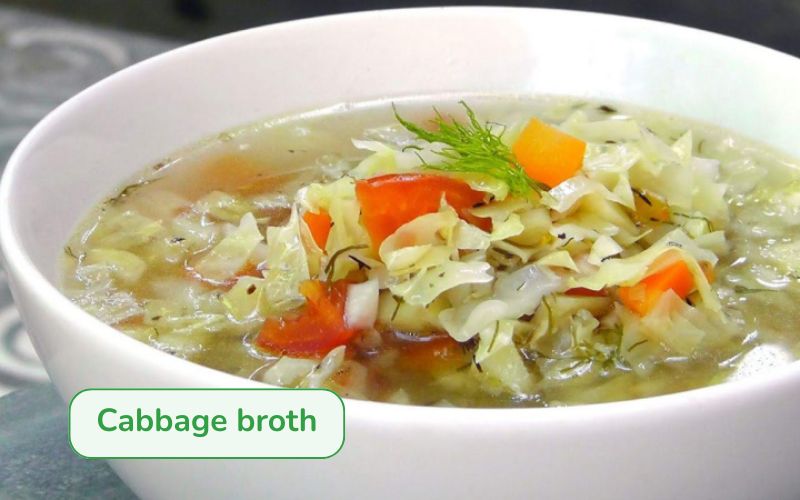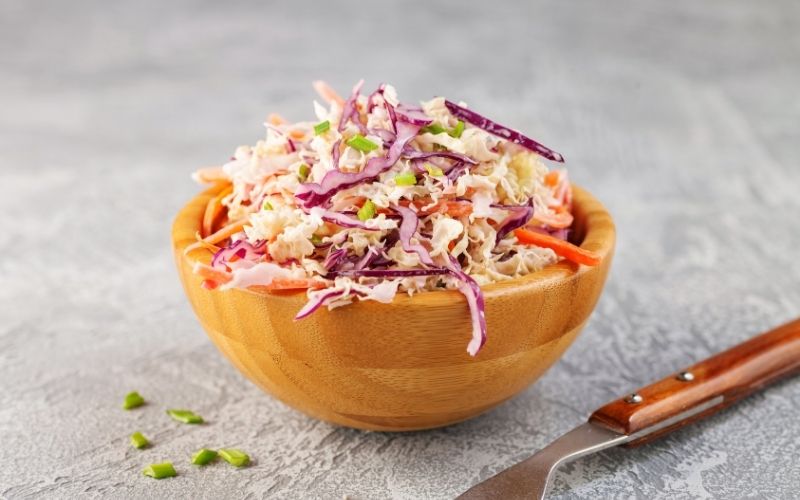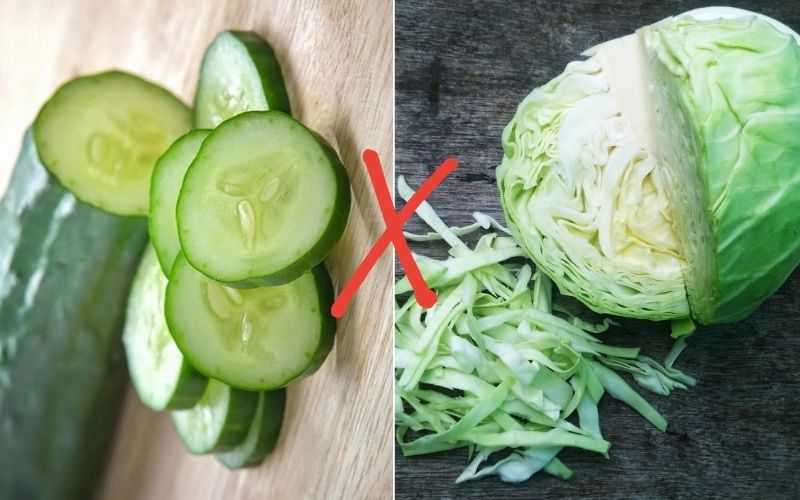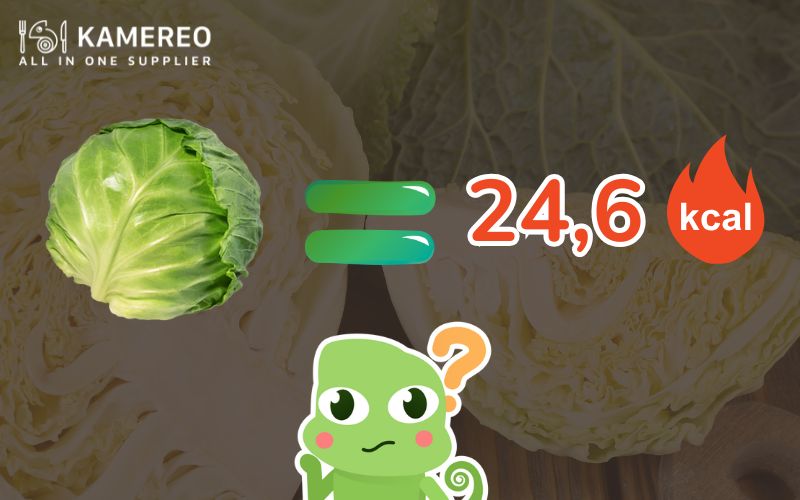“How many calories are in cabbage?” is a common question, especially for those pursuing a healthy diet. With its low-calorie content, rich fiber, and vitamins, cabbage is an ideal vegetable for weight management and supporting the digestive system. If you’re looking for an effective way to lose weight, don’t miss the information in Kamereo’s article below!
According to the U.S. Department of Agriculture, 100g of cabbage contains the following nutritional information:
|
Component |
Content |
|
Calories |
24.6kcal |
|
Fat |
0.1g |
|
Sodium |
18mg |
|
6g | |
|
Fiber |
2.2g |
|
Sugar |
2.9g |
|
1.3g | |
|
Potassium |
170mg |
|
Folate |
38.3mcg |
|
67.6mcg | |
|
32.6mg |
How Many Calories Are in Cabbage?
Cabbage is one of the most popular vegetables in diets due to its low-calorie content. 100g of red cabbage provides only about 31.1 calories. 100g of white cabbage contains only about 24.6 calories. With this modest calorie count, you can comfortably add cabbage to your daily menu without worrying about weight gain, making it easy to control your calorie intake.

How Many Calories Are in Boiled Cabbage?
When prepared by boiling, 100g of boiled cabbage provides approximately 33 calories. This is still a very low number, allowing you to eat boiled cabbage without worrying about calorie intake, especially during weight loss. Furthermore, the abundant fiber and water content in boiled cabbage help you feel full longer, reduce cravings for snacks, and thereby control weight more effectively.
How Many Calories Are in Sautéed Cabbage?
100g of sautéed cabbage typically contains about 56 calories. Although this calorie count is slightly higher than boiled cabbage, it’s still relatively small compared to many other dishes. Therefore, you can certainly incorporate sautéed cabbage into your weight loss diet to diversify your meals and avoid monotony. However, remember to control the amount of cooking oil, salt, and sugar used in preparation, as they can significantly increase the total calorie count of the dish.
Does Eating Cabbage Help with Weight Loss?
Cabbage is considered an ideal food for weight loss. Thanks to its high fiber and water content, this vegetable helps you feel full longer, curb cravings, and thus control the amount of calories and fat consumed. At the same time, the nutrients in cabbage also promote faster fat burning. Currently, the 7-day cabbage weight loss method is being adopted by many people. However, consuming cabbage for an extended period can weaken the immune system due to the body’s lack of vitamins and minerals that cabbage does not provide.

Cabbage Dishes for Weight Loss
You can eat about 200g – 300g of cabbage per meal, which is equivalent to about 80 calories. Initially, you can eat a bit more (500g/meal), then gradually reduce it to avoid unwanted weight gain. To maintain a cabbage-based weight loss diet, you can combine it with other low-calorie foods and vary cooking methods to avoid boredom and ensure adequate nutrition. Below are some effective ways to prepare cabbage for weight loss.
Boiled Cabbage
This is the simplest cooking method but yields clear weight loss results. Boiled cabbage has a sweet, refreshing taste and is rich in fiber, helping you feel full longer and reducing cravings for snacks, thereby effectively supporting the weight loss process.

Ingredients:
- Cabbage
- Salt, seasoning powder
- Ginger
- Clean water
Instructions:
- Step 1: Wash the cabbage thoroughly, cut into bite-sized pieces.
- Step 2: Bring water to a boil, add a little salt or seasoning powder, then add the cabbage and boil for about 3 – 5 minutes. Remove from heat and add sliced ginger.
- Step 3: Remove the cabbage to a plate and enjoy. You can dip it in soy sauce to enhance the flavor.
Cabbage Salad
Cabbage salad provides abundant nutrition because cabbage is eaten raw, preserving its full vitamin and mineral content without being lost due to heat.

Ingredients:
- Red cabbage or white cabbage
- Kumquat
- Mayonnaise
- Apple cider vinegar
- Honey, salt, pepper, ice water, and some other seasonings (fish sauce, seasoning powder, sugar, chili).
Instructions:
- Step 1: Wash the cabbage thoroughly, then shred it thinly. Afterward, soak the cabbage in a bowl of ice water for about 10 minutes to maintain its crispness.
- Step 2: Remove the cabbage and drain thoroughly. Then wash and chop the chili, and squeeze the kumquat juice.
- Step 3: Mix mayonnaise, apple cider vinegar, honey, salt, and pepper in a bowl until they combine into a sauce mixture.
- Step 4: Place the cabbage in a large bowl, pour the prepared sauce from step 3 over it, and add the kumquat juice, then mix well.
- Step 5: Arrange the cabbage salad on a plate and enjoy.
Cabbage Soup
Cabbage soup is a light, nutritious dish and is very suitable for those looking to lose weight. With its low-calorie content, rich fiber, and essential vitamins, this soup helps you feel full longer, curb cravings, while still providing all the necessary nutrients for the body.

Ingredients:
- Cabbage: 1/4 head
- Carrot: 1/2 tuber
- Bell pepper: 1/2 fruit
- Spring onion: 2 sprigs
- Mint: 1 sprig
- Cilantro: 1 sprig
- Minced ginger: 1 tablespoon
- Minced garlic: 1 tablespoon
- Cornstarch: 1 tablespoon
- Olive oil: 2 tablespoons
- Vinegar: 1 tablespoon
- Salt/pepper: a pinch
Instructions:
- Step 1. Preparation: Wash cabbage, bell pepper, and slice thinly. Peel and julienne carrot. Chop the white part of the spring onion separately from the green leaves. Wash and chop mint and cilantro.
- Step 2. Sauté vegetables: Sauté the white part of the spring onion, ginger, and minced garlic with olive oil until fragrant. Add cabbage, carrot, and bell pepper, and stir-fry quickly for 2 minutes over high heat until the vegetables are firm.
- Step 3. Cook soup: Add 100ml of water and 1 teaspoon of salt to the pan, bring to a boil. Dissolve 1 tablespoon of cornstarch with 30ml of water and pour into the soup, stirring well to thicken. When the soup boils again, add vinegar, pepper, spring onion leaves, cilantro, and mint. Cook for another 2 minutes until the soup thickens, season to taste, then turn off the heat.
Health Benefits of Cabbage
In addition to actively supporting weight loss, cabbage also offers many wonderful health benefits when used appropriately:
- Boosts Heart Health: Cabbage helps reduce bad cholesterol (LDL) thanks to its high fiber content and lowers blood pressure due to its abundant potassium. In particular, cabbage also helps reduce the risk of stroke and heart attack as it’s rich in B vitamins and folate.
- Aids Digestion: Cabbage is rich in soluble fiber, which is beneficial for gut bacteria. At the same time, it’s also a source of insoluble fiber, which helps absorb water into the intestines, softens stool, and acts as a laxative, thereby improving constipation.
- Enhances Vision: Cabbage contains lutein along with other antioxidants such as zeaxanthin and vitamin C, which help protect the retina and lens from damage caused by ultraviolet rays.
- Good for the Immune System: Vitamin C in cabbage helps strengthen the body’s immune system. Antioxidants also stimulate the activity of white blood cells and T cells, thereby boosting immunity.
- Supports Cancer Prevention: Cabbage contains sulforaphane, a sulfur compound that gives cruciferous vegetables their characteristic bitter taste. Many molecular-level studies have shown promising results of sulforaphane in preventing various types of cancer, including melanoma, esophageal cancer, prostate cancer, and pancreatic cancer.

Important Notes When Consuming Cabbage
If you want to maximize the benefits of cabbage and avoid unwanted side effects, you need to keep a few important things in mind:
People Who Should Not Eat Cabbage
Although cabbage is healthy, some individuals need to limit or consult a doctor before consuming it:
- People with thyroid disease: Consuming too much cabbage can lead to the absorption of harmful substances like goitrin, an antioxidant that inhibits thyroid function, worsening the condition.
- Diabetics taking hypoglycemic drugs: Cabbage has the ability to lower blood sugar. When cabbage is combined with diabetes medication, it can cause excessive hypoglycemia. Therefore, you should limit its use or consume it in moderation.
- People using paracetamol or liver-metabolized drugs: Eating cabbage while taking paracetamol can reduce the drug’s effectiveness. Similarly, if you are taking any drugs metabolized by the liver, such as metoprolol or atorvastatin, you should consult your doctor before eating cabbage.
- People using blood thinners (warfarin): Warfarin is a drug that slows blood clotting, while cabbage contains vitamin K, which promotes blood clotting, reducing the effectiveness of Warfarin.

Notes When Eating Cabbage
When preparing and consuming cabbage, users need to remember the following important notes to ensure health and optimize benefits:
- Pregnant women should limit raw cabbage: Raw cabbage contains a large amount of goitrogen, which can affect the thyroid and negatively impact the nervous system and brain of the fetus. Therefore, pregnant women should eat cooked cabbage to ensure safety.
- Do not consume cooked cabbage left overnight: Cooked cabbage left overnight can produce a large amount of nitrates. If eaten regularly for a long time, this can increase the risk of cancer.
- Do not cook cabbage at excessively high temperatures: During preparation, you need to be careful not to stir-fry or boil cabbage for too long over high heat. This can lead to a loss of important nutrients and cause cabbage to lose its natural sweetness. To retain its full nutrients, you should only boil or steam cabbage for about 5 – 7 minutes.
Foods Incompatible with Cabbage
Here are some foods you should not combine with cabbage to avoid reducing nutritional value or causing indigestion:
- Cucumber: Eating cabbage with cucumber can reduce Vitamin C absorption, while also decreasing the nutritional value of both foods.
- Mangosteen: This combination can hinder the body’s absorption of nutrients and add a burden to the digestive system.
- Apple: Similarly, apples can limit nutrient absorption when eaten with cabbage.
- Animal liver: The nutritional value of the dish will significantly decrease when combining animal liver with cabbage.

Conclusion
Above is detailed information about how many calories are in cabbage and the wonderful benefits this vegetable brings. If you want to prepare delicious dishes from cabbage yourself, don’t forget to choose fresh ingredients from Kamereo and follow more interesting information in the Food and Lifestyle section!
See more:
References:



